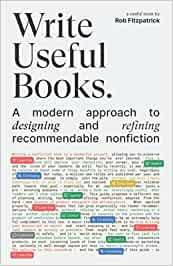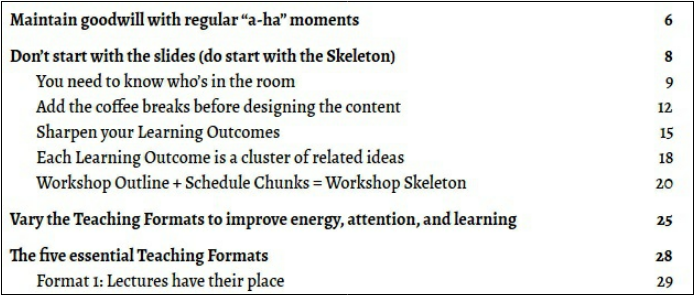Write Useful Books
This book offers a different way to plan, write, test, and refine non-fiction books that are useful. Its central theme is this: Write a book so startlingly useful that readers can’t stop talking about it. Write a book that can grow organically via reader recommendations for many years, without relying on either heavy marketing or a large author platform.

Marketing a useful book is the easiest thing in the world.
The most reliable path toward that goal - especially for an unproven author who lacks a pre-existing audience - is to write a book so startlingly useful that readers can’t stop talking about it.
Stop writing your book in secret and start exposing it to - and learning from real readers as quickly as possible.
Foundations for Long-Lasting Organic Growth
You must create something that is able to stand out and succeed.
Useful books are problem-solving products. They’re useful, actionable, and clarifying. They’re built like products. Useful books help a reader achieve a tangible outcome:
- Accomplish a goal
- Answer a question or understand a concept
- Improve a skill or develop a toolkit
- Resolve a fear or inspire change
- Adjust perspective to improve their life
What’s your book’s promise to its reader?
Make a clear promise and put it on the cover. The book’s title and sub-title should clearly emphasize the promise to the reader. What are they going to get out of it?
The best way to get there is to try saying it in conversation. When someone asks what you’re working on, attempt to describe the book in just one or two sentences. Each time you try describing it to someone, you’ll get a little bit closer.
Decide who it isn’t for
Here’s the secret to a five-star rating: be clear enough about what your book is promising that people can decide they don’t need it.
If you’re writing for beginners, don’t worry that the expert finds it basic. If you’re writing for experts, don’t worry that the beginner will be confused. Clearly state who this book is not for.
You need to become the best. Not for everyone, but for someone. You do that by speaking directly to their situation and context by excluding everybody else.
Decide the book’s scope
Scope = Promise + Reader Profile + Who it isn’t for + What it won’t cover
Your book is under no obligation to start from the beginning, to serve everybody, or to cover everything.
Pick the piece you’re best at, for the people you care most deeply about serving, at the moment in their journey where you can really help them, and forget about everything else. These crucial decisions will define your book’s scope.
What does your ideal reader already know and believe?
Your own goals and interests should guide the book’s scope. Tighten and strengthen the book’s scope using these questions:
- When someone decides to buy and read your book, what are they trying to achieve or accomplish with it? Why are they bothering? After finishing it, what’s different in their life, work, or worldview?
- What does your ideal reader already know and believe? If they already know the basics, skip them.
- Who is your book not for, and what is it not doing? If you aren’t clear on who you’re leaving out, then you’ll end up writing yourself into rabbit holes.
Deep Books vs. Ineffective Problem Solvers
Deep = Desirable + Effective + Engaging + Polished
Desirable: Your readers want what it’s promising.
Effective: It delivers real results for the reader.
Engaging: It’s front-loaded with value, has high value-per-page, and feels rewarding to read.
Polished: Professionally written and presented.
Design for word-of-mouth publicity
Recommendability removes competition.
The recommendation loop is where someone complains about a problem or seeks a solution to a high-priority problem. If that problem happens regularly enough, then the book’s growth becomes self-sustaining.
Write out this recommendation story for your own book idea. What are the different contexts where people might recommend your book to others?
Timeless Content
You get compounding benefits by writing something that will remain relevant for many years.
- Pick a promise that will remain relevant and important for 5+ years.
- Avoid overreliance on temporary tools, trends, and tactics that are likely to become quickly dated.
Reader Conversations
Talk with your readers for testing and improving the book.
You don’t build a house before considering the needs and requirements of the people who will live there. Why are you writing a book without gathering feedback from the intended readers?
Listening and teaching are part of writing
A guiding principle of product design is that the more iterations you can do - while in front of real users - the better the product will become.
As the author, you’ll typically be more experienced than your readers. To write something useful, you’ll need to get back inside their heads and see the topic from their perspective.
This sort of “reader empathy” allows you to escape the curse of knowledge and anticipate common questions, objections, concerns, and confusion. It will help you strike the right tone, tempo, and level of detail, making your early drafts ineffably better.
Fill your table of contents with takeaways, not clickbait.

Use clear, descriptive language. Write detailed sub-sections.
What is this chapter’s learning outcome or takeaway? What does the reader gain from reading it?
Teach the book to test its contents
Even the greatest standup comedians still test their fresh material in tiny basement bars, ready to face the confused silence of an unamused crowd.
You’ll want to follow more or less the same approach, which you can accomplish by “becoming the book” and teaching its contents to your future readers.
By helping them through the process yourself, you’ll learn what they need, and in what order. You’ll figure out which examples resonate and which exercises work. All of which will improve both your ToC and your soon-to-be-written manuscript.
Write the First Draft
Just write it without worrying about anything. It is supposed to be a mess. The main idea is to avoid slowing yourself down by rereading, self-judging, or fretting over what you’ve written.
You’ll begin to reread, evaluate, and improve it during the second and third drafts. But for now, just get it down on paper.
The first draft is just to help you think.
Stop writing for an anonymous crowd; imagine yourself writing to a specific individual who you know, and who wants your help. Stop trying to sound smart. Use the same tone and language that you would use to explain something to a friend or colleague.
Define your schedule, do the work
Pick a time when you’ll sit at your desk and then sit there and write it. Steven Pressfield describes it the best in The War of Art:
How many pages have I produced? I don’t care. Are they any good? I don’t even think about it. All that matters is I’ve put in my time and hit it with all I’ve got. All that counts is that, for this day, for this session, I have overcome Resistance.
An hour is plenty, but you’ve got to carve it out, defend it, do the work, and then show up again tomorrow.
Improving Readability and Value-per-Page
Design your book for maximum readability and value delivered per page.
For a reader, your book is a multi-hour journey experienced as value received over time spent. If too much time passes before the reader gets the next meaningful value, the reader will drift away.
Designing a strong reader experience means deciding exactly how to pace and where to place your book’s major insights, takeaways, action steps, and “a-ha” moments.
Front-load the value
The more value your reader gets from your book, the more they recommend it. They’re also more likely to abandon reading it at the beginning. Hence deliver as much value as possible at the start, when they are most engaged.
Three ways to deliver more value up-front:
- Delete the lengthy front matter (introduction, foreword, bio, etc.) that isn’t delivering value
- Delete the theory, context, foundation, etc., that isn’t absolutely required
- If your book is building towards the grand conclusion, reveal it at the beginning.
Revising into third draft
The best way is to read it all every day from the start, correcting it as you go along. - Hemingway
Reading it from end to end helps you notice major repetitions, inconsistencies, and slogs.
While doing these revisions, focus on the big-picture issues of structure, clarity, and reader experience.
Reread it. Revise it. Restructure it. Refine the reader’s experience. Front-load the value. Remove the chapters and sections that don’t apply to your ideal readers.
Marketing to Find First 1000 Readers
Make things and tell people.
If you are starting over with absolutely zero resources, reputation, or connections, start writing in public to build a small author platform via content marketing and writing in public. This is a time-intensive process, but the most reliable way to market your book.
Your marketing is just sharing the work you’re already doing on the manuscript.
You can write your book in public, chapter-by-chapter or section-by-section, and just continually release it to an ever-growing audience. Doing this consistently, every single week, will build your audience whether you like it or not.
Get emails to convert interest into an audience. In terms of value-per-follower, email is orders of magnitude better than social media.
Once a day, after you’ve done your day’s work, find one little piece of your process that you can share.
If you’re in the very early stages, share your influences and what’s inspiring you.
If you’re in the middle of executing a project, write about your methods or share work-in-progress.
If you’ve just completed a project, show the final product, share scraps from the cutting-room floor, or write about what you learned.
Austin Kleon, Show Your Work
Conclusion
You can intentionally design and refine a book toward maximizing word-of-mouth and back-catalog potential.
You probably can’t write the world’s best book about a huge topic for every type of reader. Decide who you’re serving and how you’re helping them, and then write just for them.
While writing and revising, pay attention to the reader experience. Maximize the value received over time spent reading your book. The book should be as short as possible, and its value should be front-loaded. Don’t get stuck in theory, and don’t delay the big reveal.
Action Steps
- Make a clear promise and put it on the cover. The book’s title and sub-title should clearly emphasize the promise to the reader.
- Clearly state who this book is not for.
- The recommendation loop is where someone complains about a problem or seeks a solution to a high-priority problem. Think: What are the different contexts where people might recommend your book to others?
- Teach your book’s contents to your future readers to develop ‘reader empathy’.
- Read it frequently from end-to-end and edit as you read.
- Share your knowledge via a blog to build a meaningful audience.